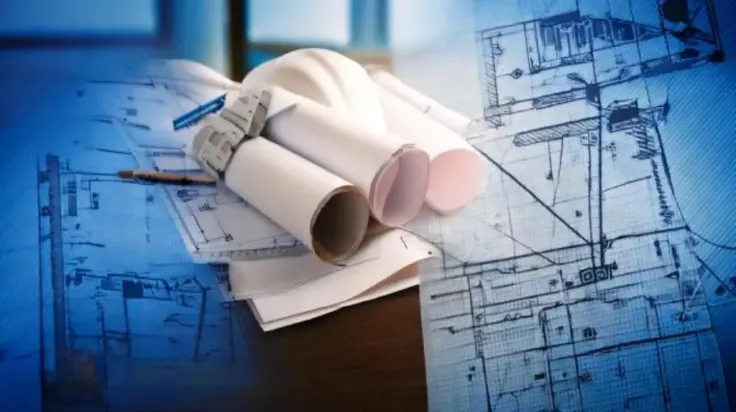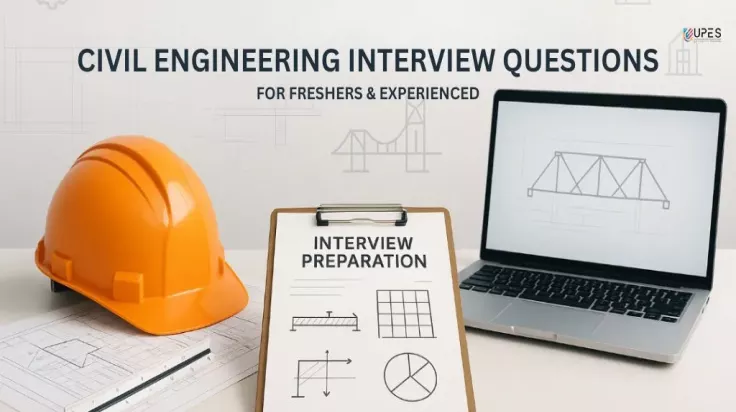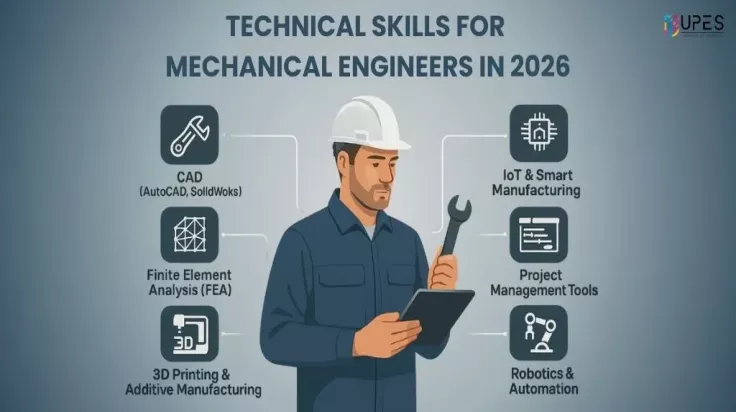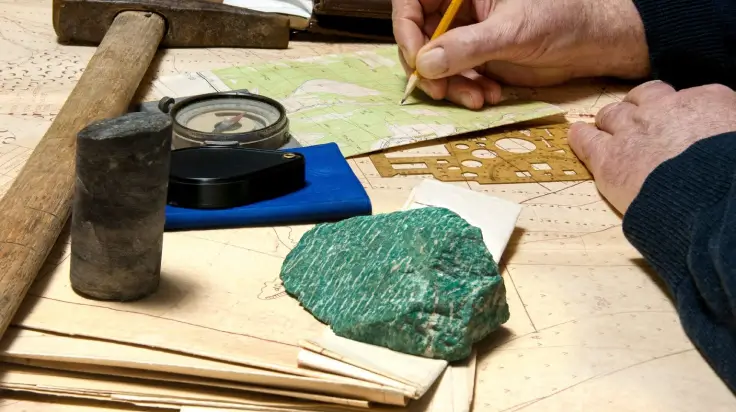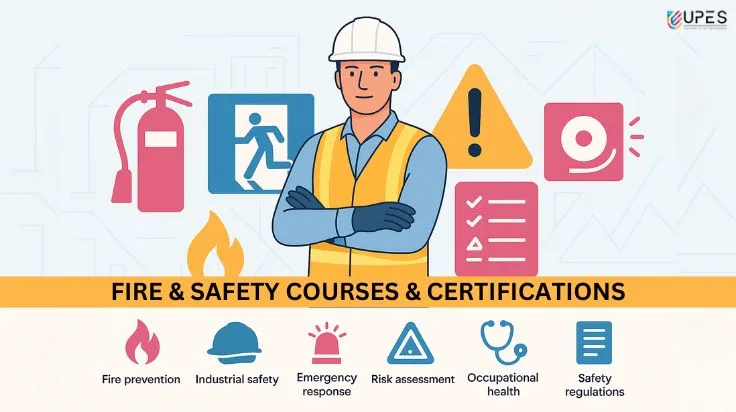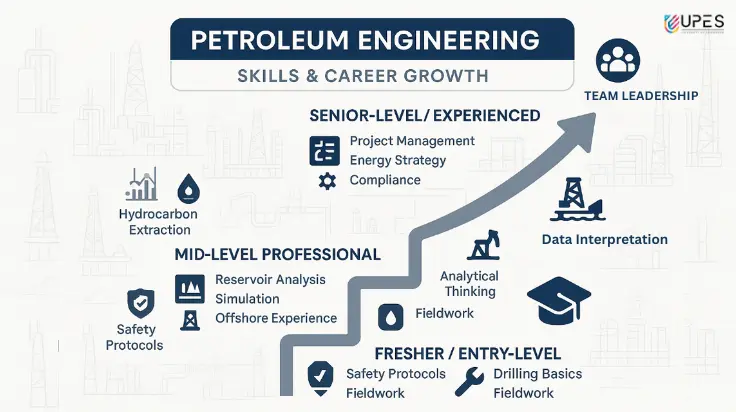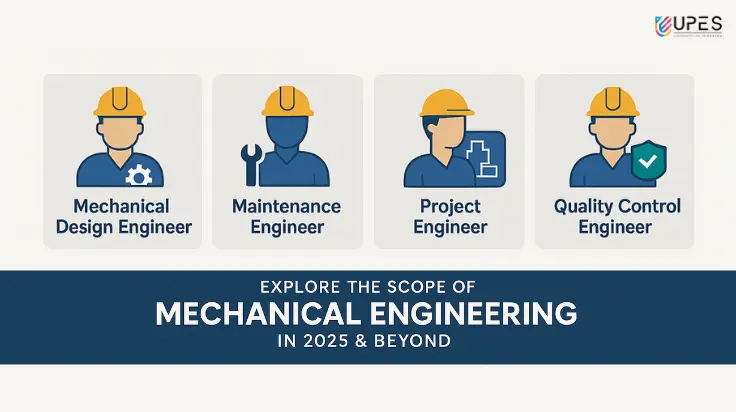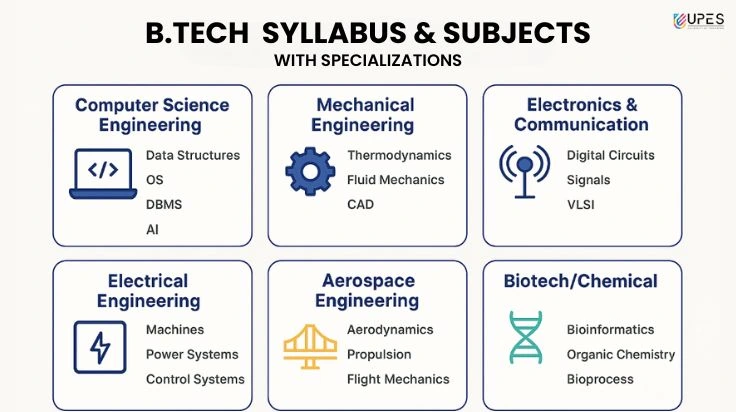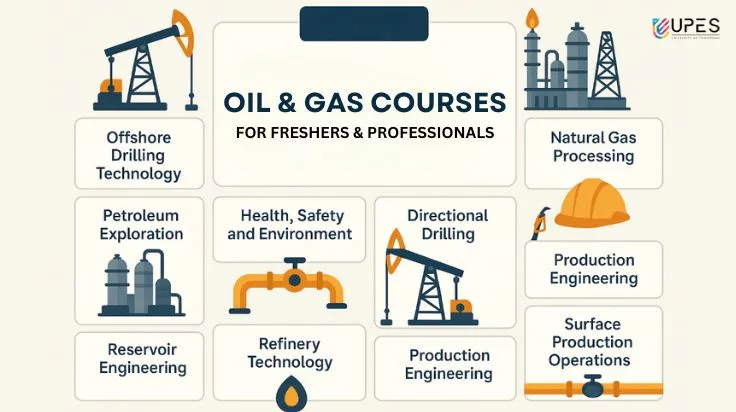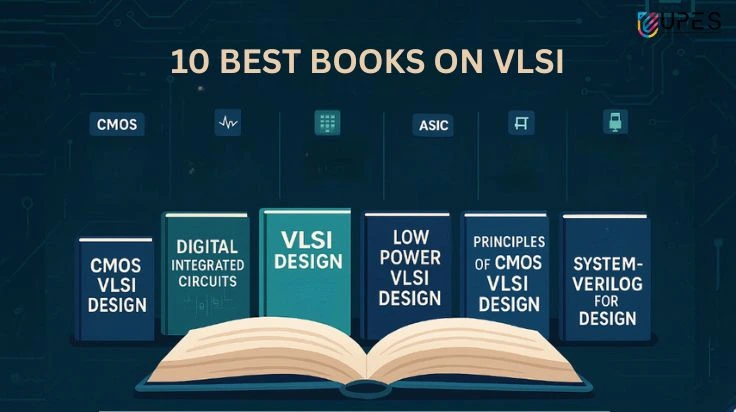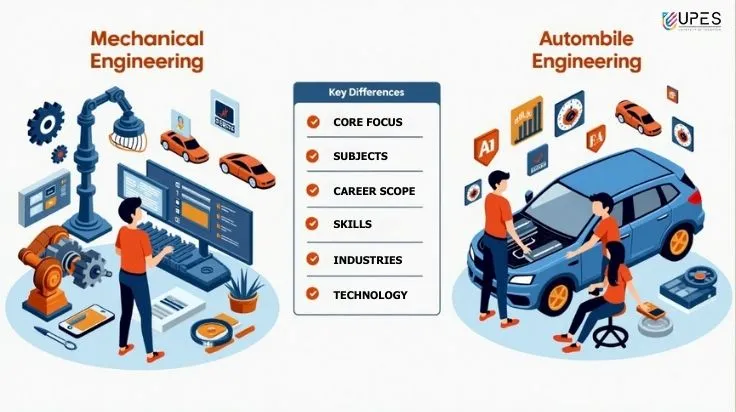Tools for Civil Engineers: Types & Where to Use
- UPES Editorial Team
- Published 14/07/2025
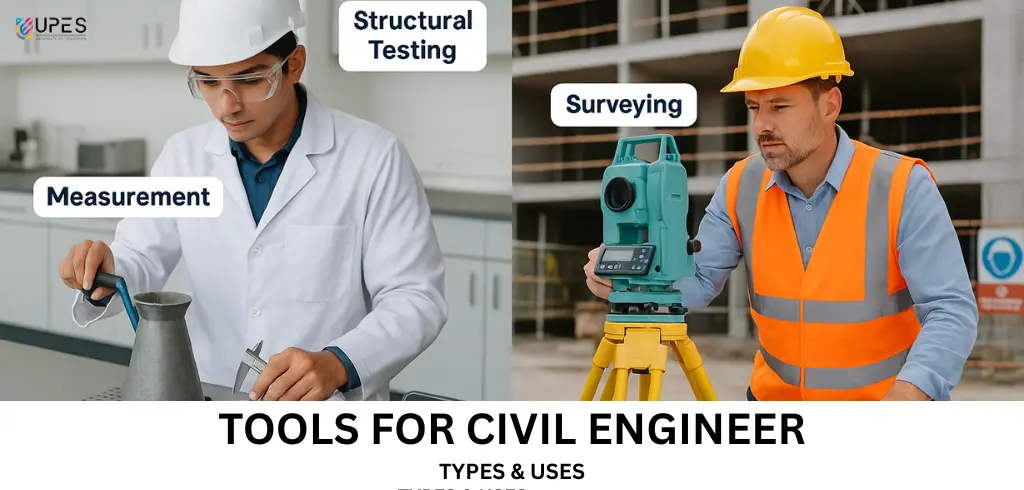
Civil engineering, one of the oldest and most dynamic branches of engineering, relies heavily on precision, planning, and the right equipment. Whether it's laying the foundation of a smart city or constructing a flood-resistant bridge, the accuracy and quality of civil engineering projects are shaped by the tools for civil engineers.
Become future-ready with our Advanced Engineering programs
Know MoreIn this blog, we explore the essential civil engineering tools, their classifications, and how they're used in real-world construction and infrastructure projects.
Why Tools Matter in Civil Engineering
The success of any civil engineering project—be it surveying land or curing concrete—rests not just on design and materials, but on the correct usage of civil engineering equipment. The right instruments ensure safety, cost-efficiency, and compliance with technical standards. As civil engineers move toward more sustainable and smart infrastructure, their reliance on modern civil engineer tools continues to grow.
This becomes even more critical in a rapidly evolving profession. As highlighted in the broader future of civil engineering, modern construction demands professionals who are proficient in both traditional and smart technologies.
Types of Civil Engineering Tools and Instruments
Civil engineering tools can be broadly categorized into:
- Surveying Instruments
- Construction Tools
- Material Testing Instruments
- Safety Equipment
- Digital and Smart Tools
Each category plays a critical role in different phases of a civil project—from planning to completion.
1. Surveying Civil Engineering Instruments
Purpose: Measurement, alignment, and site planning
Surveying tools form the backbone of any infrastructure project. These surveying civil engineering instruments help engineers determine land elevations, boundaries, and gradients.
Common Tools:
- Theodolite: Measures horizontal and vertical angles with high precision
- Total Station: Combines electronic distance measurement and angle measurement
- Auto Level: Used for precise leveling
- Measuring Wheel: Measures distance on the ground quickly and efficiently
Where to Use: Site planning, road construction, bridge design, urban infrastructure
2. Construction Tools for Civil Engineers
Purpose: On-site construction tasks like mixing, lifting, digging, and plastering
Basic tools are essential for execution. These civil engineering tools are usually handheld but critical to the success of fieldwork.
Common Tools:
- Trowel: For finishing mortar or plaster
- Concrete Mixer: Combines cement, sand, gravel, and water
- Wheelbarrow: Transports materials on site
- Jackhammer: Breaks concrete or pavement
Where to Use: Concrete casting, roadwork, wall construction, slab finishing
Check Out: UPES Faculty Decodes Geohazards in Joshimath
3. Material Testing Equipment in Civil Engineering
Purpose: Assessing strength, durability, and compliance of construction materials
Material testing is vital for ensuring project longevity and structural integrity. These civil engineering instruments help identify defects and confirm quality.
Common Equipment:
- Compression Testing Machine (CTM): Tests strength of concrete cubes or cylinders
- Slump Cone: Measures workability of fresh concrete
- Sieve Shaker: Determines aggregate grading
- Ultrasonic Pulse Velocity Tester: Assesses concrete homogeneity
Where to Use: Quality control labs, R&D facilities, on-site concrete assessment
For a deeper understanding of how these tools contribute to modern infrastructure, explore the scope of civil engineering in the Indian and global context.
4. Safety and Protective Equipment
Purpose: Worker safety and compliance
Safety is paramount in civil projects, especially in high-risk areas like high-rise buildings or highways. Hence, civil engineering equipment isn't limited to tools that shape concrete but also includes equipment that safeguards lives.
Common Safety Gear:
- Hard Hats: Protect against falling debris
- High-Visibility Vests: Ensure worker visibility
- Safety Harnesses: Used in high-altitude construction
- Dust Masks & Ear Protection: Mitigate exposure to pollutants and loud machinery
Where to Use: All construction and survey sites
To better understand related fields, consider reading about the key differences between electrical and electronics engineering, especially if your interests lie in digital systems or communication technologies.
5. Digital Tools and Smart Instruments
Purpose: Automation, data analytics, and design precision
Digital transformation has ushered in a new era in civil engineering. These civil engineering equipments use software and sensors to automate routine work and improve decision-making.
Popular Tools:
- Drones: For aerial surveys and real-time site inspections
- GPS Devices: For accurate geolocation data
- BIM Software (e.g., Revit, AutoCAD Civil 3D): For collaborative design and modeling
- Laser Scanners: For creating 3D models of terrain and structures
Where to Use: Urban planning, smart cities, large infrastructure projects, pre-construction surveys.
AI Tools for Civil Engineers
Be it automating tasks, optimizing designs, and improving project management, civil engineers now amply use various AI tools used by civil engineers to smoothen the process for them. They also depend on AI tools for optimizing building designs, predicting infrastructure failures, and improving traffic flow.
Here’s a comprehensive table of AI tools for civil engineers, along with their purpose, use cases, and benefits:
| AI Tool | Purpose | Where to Use | Benefits |
| Autodesk Civil 3D | Civil infrastructure design & documentation | Roadway design, land development, stormwater systems | Automates grading/alignment, integrates with BIM, reduces design time |
| Bentley OpenRoads/OpenBuildings | Intelligent modeling and simulation | Highways, railways, buildings | Uses AI for clash detection, design optimization, and real-time simulation |
| Spacemaker AI | AI-powered generative design | Urban planning, zoning, sustainability | Optimizes land use, noise, daylight; generates smart, eco-friendly designs |
| Smartvid.io | Site safety monitoring using video analytics | Construction sites | Detects safety violations, reduces risk, automates compliance tracking |
| Delve | Urban design based on zoning & financial data | Real estate, urban planning | Generates design options, balances density, sunlight, and profitability |
| nPlan | Predicts project delays using historical data | Project scheduling, infrastructure projects | Optimizes timelines, reduces risk of cost overruns |
| Buildots | Construction progress tracking via 360° cameras | Commercial/infrastructure construction | Detects BIM deviations, speeds up decision-making |
| Togal.AI | Automates quantity takeoffs for cost estimation | Estimating and bidding | Saves time, improves bid accuracy |
| CityFormLab | Urban form analysis using machine learning | Traffic flow, accessibility, urban equity | Supports data-driven urban planning for smart cities |
Through a blend of creativity, artificial intelligence, and technology, the path to civil engineering is getting revamped to new successes, projects, and ambitions.
Software Tools for Civil Engineers:
Design analysis, project management, structural analysis, and many more tasks require the expertise of software tools that can help simplify a complex civil engineering requirement. Here’s a curated list of the 10 most used software tools for Civil Engineers in 2026, covering planning, design, drafting, analysis, and project management. Each tool is categorized with its purpose, common applications, and key benefits.
| Software Tool | Purpose | Where It's Used | Key Benefits |
| AutoCAD | 2D drafting & detailing | Structural drawings, floor plans, elevation & section views | Widely accepted, easy to learn, accurate drafting & annotation tools |
| Revit | 3D BIM modeling | Architecture, MEP, structural detailing | Parametric modeling, clash detection, real-time collaboration |
| STAAD.Pro | Structural analysis & design | Buildings, bridges, towers | Supports multiple codes, steel & concrete design, easy load combinations |
| ETABS | High-rise structural design | Multistory buildings, seismic analysis | Integrated modeling, analysis & design for tall structures |
| SAP2000 | General structural analysis | Dams, towers, stadiums | Intuitive UI, non-linear analysis, dynamic load simulation |
| Primavera P6 | Project planning & scheduling | Infrastructure & construction project timelines | Critical path method (CPM), resource & cost management |
| Microsoft Project | Project management | Small to mid-scale construction projects | Task allocation, Gantt charts, time-cost tracking |
| Civil 3D | Civil design & documentation | Roads, land development, pipe networks | Corridor modeling, earthworks, dynamic link to AutoCAD |
| Plaxis | Geotechnical & foundation analysis | Soil-structure interaction, retaining walls, embankments | Advanced FEM modeling for soils, pore pressure analysis |
| SketchUp | Conceptual 3D modeling & visualization | Landscape, urban planning, design presentations | Quick modeling, integrates with VR/AR tools, easy for non-technical clients |
These tools are essential across different civil engineering domains:
- Design & Drafting: AutoCAD, Revit, Civil 3D
- Structural Analysis: STAAD.Pro, ETABS, SAP2000
- Project Management: Primavera P6, MS Project
- Geotechnical: Plaxis
- Visualization & Planning: SketchUp
To stay ahead in the game of civil engineering, it is important to stay updated with innovative software. Adding these software programs to your toolset will greatly increase your productivity and help your civil engineering projects succeed, whether you're drafting blueprints, simulating structures, or producing realistic visualizations.
Drawing Tools for Civil Engineering
Civil engineers often need to accurately represent design on paper taking the help of different drawing tools. After all it is hard to imagine a civil engineer without drawing tools!
Listed below is a comprehensive table of drawing tools for Civil engineering often used in the field:
| Tool Name | Purpose | Where to Use | Benefits |
| T-Square | Drawing horizontal lines | Manual drafting on drawing sheets | Ensures straight, level lines with accuracy |
| Set Squares (45° & 60°) | Drawing angles and vertical lines | Used with T-squares in manual drafting | Helps in creating angles, perpendiculars, and elevations |
| Protractor | Measuring and drawing angles | Road geometry, slope analysis | Precise angle measurements and layouts |
| Compass and Dividers | Drawing circles/arcs and transferring distances | Curved structures, site layouts | Essential for precision in curves and radii |
| Drawing Board | Flat surface for manual drafting | Used in drafting labs and site planning | Stable platform for accurate drawings |
| Engineering Scale (Triangular Scale) | Scaling dimensions in drawings | Reading and converting engineering drawings | Converts between full-size and scaled drawings easily |
| Drafting Machine | Combines T-square and set square functionality | Advanced manual drafting | Enhances efficiency and precision |
| AutoCAD | 2D drafting and detailing | Floor plans, structural layouts, piping, etc. | Speeds up drawing creation, editing, and sharing |
| Revit | BIM-based 3D modeling and detailing | Building layouts, MEP systems, documentation | Parametric modeling with real-time collaboration |
| SketchUp | 3D sketching and visualization | Urban design, landscape, site planning | Intuitive tool for fast concept development |
| STAAD.Pro | Structural analysis and design (with drawing output) | Structural detailing and reinforcements | Outputs drawing-friendly structural designs |
| MicroStation | CAD software for infrastructure projects | Roadways, rail, bridges | Powerful modeling, drawing, and geospatial support |
| BricsCAD | 2D/3D CAD with AI tools | General drafting for civil engineering | Cheaper alternative to AutoCAD with similar UI |
This table includes both traditional and software-based tools used by civil engineers.

Our counsellors are just a click away.
Using the Right Tools
From surveying civil engineering instruments to advanced BIM tools, the diversity of tools for civil engineers reflects the complexity of the profession. Each tool has a distinct function but together they help civil engineers build resilient, safe, and future-ready infrastructure.
As the demand for skilled engineers grows, understanding when and how to use these civil engineering instruments becomes a critical part of professional training. At institutions like UPES School of Advanced Engineering, students receive hands-on training with both traditional and smart tools, bridging academic learning with industry readiness.
By staying updated with these essential tools and their applications, aspiring civil engineers can ensure they are not just job-ready, but future-ready.
UPES Editorial Team
Written by the UPES Editorial Team
UPES Admission Enquiry
Subscribe to UPES Blogs
Join our community for exclusive stories, insights, and updates
By clicking the "Subscribe" button, I agree and accept the privacy policy of UPES.










